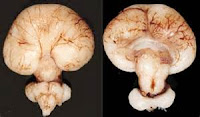February 5, 2016
What (causes holoprosencephaly):
The exact cause is unknown. There are some speculations that it could be genetic and or from the environment. Environment risk factors would include maternal diabetes, infections during pregnancy (syphilis, toxoplasmosis, rubella, herpes, cytomegalovirus). The mother could have taken various drugs, whether it was a prescribed medication or street drugs. The mother could also had a previous pregnancy loss or had bleeding during the
first trimester (Carterdatabase). There have been six human genes that have been found to be associated with holoprosencephaly and seven other defective chromosome loci to be linked. The six genes are: SHH, SIX3, ZIC2, TGIF, PTCH, and DKK (Roesler, 2006). The SHH gene, which provides instructions for making a protein called Sonic Hedgehog, was the first known gene to cause holoprosencephaly. This protein functions as a chemical signal that is essential for the embryonic development. It plays an important role in cell growth, cell specializations, and the normal shaping of the body. It's very important for the development of the
brain and spinal cord, eyes, limbs, and other parts of the body.
 |
| Sonic Hedgehog protein |

How and Why:
There is a malformation of the brain during the first four weeks of embryogenesis. It results in an incomplete cleavage of the cerebral hemispheres. The Sonic Hedgehog protein is necessary for the development of the forebrain. It helps establish the line that separates the right and left sides of the forebrain. Specifically the midline for the underside of the forebrain, making the ventral surface (SHH gene, 2016).
There are more children surviving mild to moderate forms of holoprosencephaly and into adulthood. Most children have severe motor impairment with varying degrees of functional expressive speech and language skills.
References
The Carter Centers for Brain Research in Holoprosencephaly and Related Malformations. (n.d.).
Retrieved February 5, 2016, from
http://www.carterdatabase.org/hpe/
Roesler, C. P., Paterson, S. J., Flax, J. S., Kover, C., Stashinko, E. E., ...Benasich, A. A. (2006). Links
between abnormal brain structure and cognition in holoprosencephaly.
Pediatric Neurology,
35(6), 387-394.
http://doi.org/10.1016/j.pediatrneurol.2006.07.004
SHH gene. (2016, February 1). Retrieved February 5, 2016, from
http://ghr.nlm.nih.gov/gene/SHH




